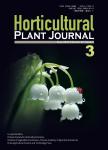Analysis of the Fungal Community in Apple Replanted Soil Around Bohai Gulf
Analysis of the Fungal Community in Apple Replanted Soil Around Bohai Gulf作者机构:State Key Laboratory of Crop Biology/College of Horticultural Science and Engineering Shandong Agricultural University College of Chemistry and Material Science Shandong Agricultural University Shandong Instiute of Pomology Yantai Academy of Agricultural & Science Garden Office of Linyi Lanshan
出 版 物:《Horticultural Plant Journal》 (园艺学报(英文版))
年 卷 期:2018年第4卷第5期
页 面:175-181页
核心收录:
基 金:supported by the earmarked fund for the National Modern Agro-industry Technology Research System(CARS–27) the National Natural Science Foundation of China(31501720 and 31672104) the National Key Research and Development Program of China(2016YFD0201114) the Fruit innovation team in Shandong Province,China(SDAIT-06-07) Agricultural Major Application Technology Innovation Project of Shandong Province the joint project of the Shandong Natural Science Foundation,China(ZR2014CL024)
主 题:apple replanted disease Fungi clone library fusarium fungal community
摘 要:Apple replant disease(ARD) is a frequently occurring plant disease in replanted orchards around Bohai Gulf, which causes growth inhibition and even death of plants. The aim of this study was to investigate the etiology of ARD around Bohai Gulf. In this study, the primary growth inhibition of apple seedlings was evaluated in ten replanted soils, sampled around Bohai Gulf. A fungal clone library was used to identify changes in the structure and composition of the soil fungal community. The results revealed that the Simpson diversity indices of Laizhou and Pulandian orchards were higher than others, presenting severe ARD. Ascomycota dominated around Bohai Gulf at the phyla level. Fusarium and Saccharomyces were abundant in all replanted soils. In addition, correlations between the relative abundance of fungal genera in soils and the severity of ARD were analyzed. The results showed that Fusarium was correlated positively with the severity of ARD, but Mortierella was negatively correlated. Furthermore, the quantitative PCR of Fusarium oxysporum, which was regarded as a factor of ARD, was performed. Overall, this study demonstrated that ARD was strongly associated with an unbalanced microbial ecosystem with more pathogenic fungi, while Fusarium in the apple replanted soil was the key factor for ARD around Bohai Gulf.



